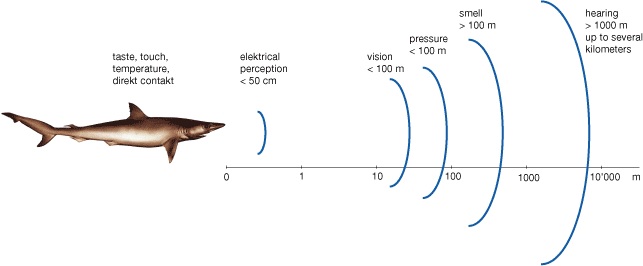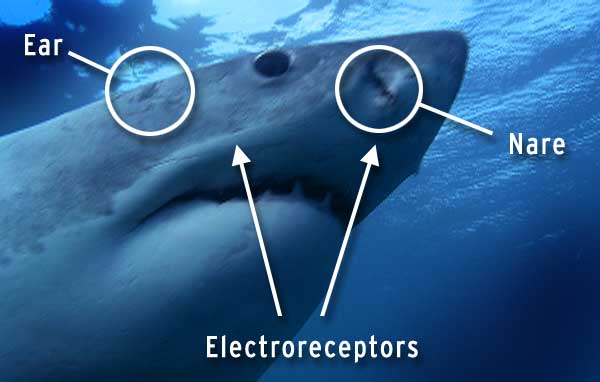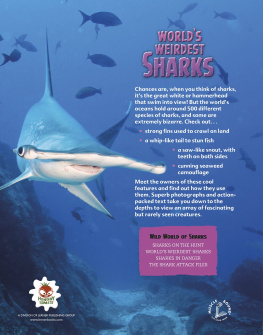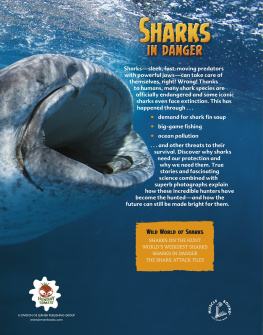The Encyclopedia ofSharks
~~**~~
Published by My Ebook Publishing House atSmashwords
Copyright 2013 My Ebook Publishing House
Smashwords Edition, License Notes
This ebook is licensed for your personal enjoymentonly. This ebook may not be re-sold or given away to other people.If you would like to share this book with another person, pleasepurchase an additional copy for each recipient. If youre readingthis book and did not purchase it, or it was not purchased for youruse only, then please return to Smashwords.com and purchase yourown copy. Thank you for respecting the hard work of thisauthor.
~~**~~
~~**~~
Other Titles from My EbookPublishing House:



~~**~~
Table of Contents
The primary senses of the sharks
Special senses
Prepared to kill
The shark eggs
The great white
The tiger shark
The white snout oceanic shark
The nurse-shark
The grey reef shark
The hammer-head fish
The blue shark
The mako shark
The spike shark
The lacy shark
The primary senses of thesharks
The sharks have very well developed senses,suitable for the underwater life. They use their senses for stayingaway from predators (animals which hunt other animals) and forhunting marine creatures which they feed on.

Always prepared forattack
The sharks might be hurt when fighting withtheir prey. But some sharks, such as the oceanic white nose shark,have the eyes covered by a protective layer of skin. A protectivelayer of skin also covers partly the eye of this oceanic white noseshark.
The sight of the sharks
The sharks have very good sight. In the deepand dark waters, the reflecting layer from the bottom of their eyeshelp them see better, acting like a mirror and enhancing this waytheir visibility, in the poor light surrounding them. In the dark,the reflecting layer from the bottom of the eye of a shark makesits eye glow.
Attacking blindly
The sharks that do not have a protective layeron their eyes, twist their eyes with the pupil inside when theyattack. Therefore they do not see the prey in the moment when theyprepare to tear it.

The hearing
The sharks ears are inside their head. Theyhave two ears, one for each side of the brain. The hearing isadapted to distinguish low frequency noises. A shark hears easilythe noise made by the motor of a boat, from a relatively greatdistance.
The smell
The sharks have two nostrils situated on theirmuzzle. They are not used for breathing, but for smelling. Theshark swims, and the water passes through its nostrils and througha special tegument which detects the smells. The wide nostrils ofthis Caribbean reef shark help it detect the fishes he feedswith.
The taste
The sharks have gustatory buds on their hardpalate and tongue. These buds help them decide if the food they areeating is good or bad. However, the sharks swallow sometimesgarbage from the sea: metal cans, plastic bags and plasticrecipients. The sharks can accidently swallow garbage from the seawhen they swim. Data about the sharks: the sharks have anespecially developed sense of smell and feel the smell of bloodfrom a three kilometers distance.
Special senses
The sharks have a few unusual senses, whichhelp them be good predators. The sharks feel the moves of thecreatures nearby and can even recognize the electrical impulsessent by these animals.

The electrical impulses detectives
All the animals emanate electrical impulsesthrough their muscles and nerves. The sharks feel these impulsesthrough the pores found on their muzzles. This way they locatetheir prey. The black spots found on the muzzle of this sand tigershark (also called the grey nanny shark) are pores through which itfeels the electrical impulses.
Biting metal
Sometimes, the sharks attack metallic objects.In the salty water of the sea, the metals transmit weak electricalimpulses which confuse the sharks. Probably, the sharks take theseobjects as a prey and plunge toward them.
Sharp senses
The sharks feel the presence of a predator orprey, without seeing it. The sharks have under their skin thincanals containing minuscule fuzzes which detect the weakest movearound them. Sharks have canals on both sides of their body, whichhelp it feel the surrounding animals.
Hidden pleasures
Some sharks that live on the bottom of the seafind their food with the aid of the tactile sense. They have smallmoustaches on their muzzle which help them feel the prey, eventhough it is hiding under the sand.
Touch and taste
The moustaches are covered with small gustativebuds, so that the sharks can touch and taste the prey at the sametime, to see if it is good to eat.
Prepared to kill
The sharks have different ways of attackingtheir prey. Most of the sharks hunt individually, but some hunt ingroups. They are usually calm hunters, but they can become agitatedkillers.

A single bite
The great white attacks its prey and bites thepursued animal only once, bears off from the victim it letshelpless or dying, then it consumes it. It avoids this way gettinghurt in battle.
Powerful bites
Some sharks can bite the prey strongly. Theycan bite strongly because their jaws are connected to their skull,and this way their mouth opens widely. When a shark opens its mouthfor biting its prey, its head and muzzle lifts, and the jaws spreadout. When the jaws are open the widest, the upper jaw and the teethmove forward, allowing the shark to bite stronger.
Group killers
Some sharks hunt in groups. For example, theblack fins reef sharks hunt together and surround the prey. Thenthey chase the fish that they hunt up to shallow waters, and thenon the beach. The sharks come out of the water then, grab the fishand swim back into the water. This is how a black fins reef sharkshunt, following the fish on the beachs sand.
Great agitation
When a group of sharks finds a shoal of fish,they can become agitated. They attack the fish with rage andsometimes bite each other in their agitation. This is called thefrenzy of feeding. These grey reef sharks found a shoal of fish andstart fidgeting.
Laying the eggs
Some shark species lay eggs. The shark cubsgrow inside the egg and hatch of the egg when they are fullydeveloped for the life in the exterior environment.
Surviving
While inside the egg, a baby shark receive foodfrom the vitelline sack attached to its body. And the water goesinto the egg, giving oxygen to the cub. In the image it can be seenthe shark baby and its vitelline sack, inside the eggsshell.
Next page





















